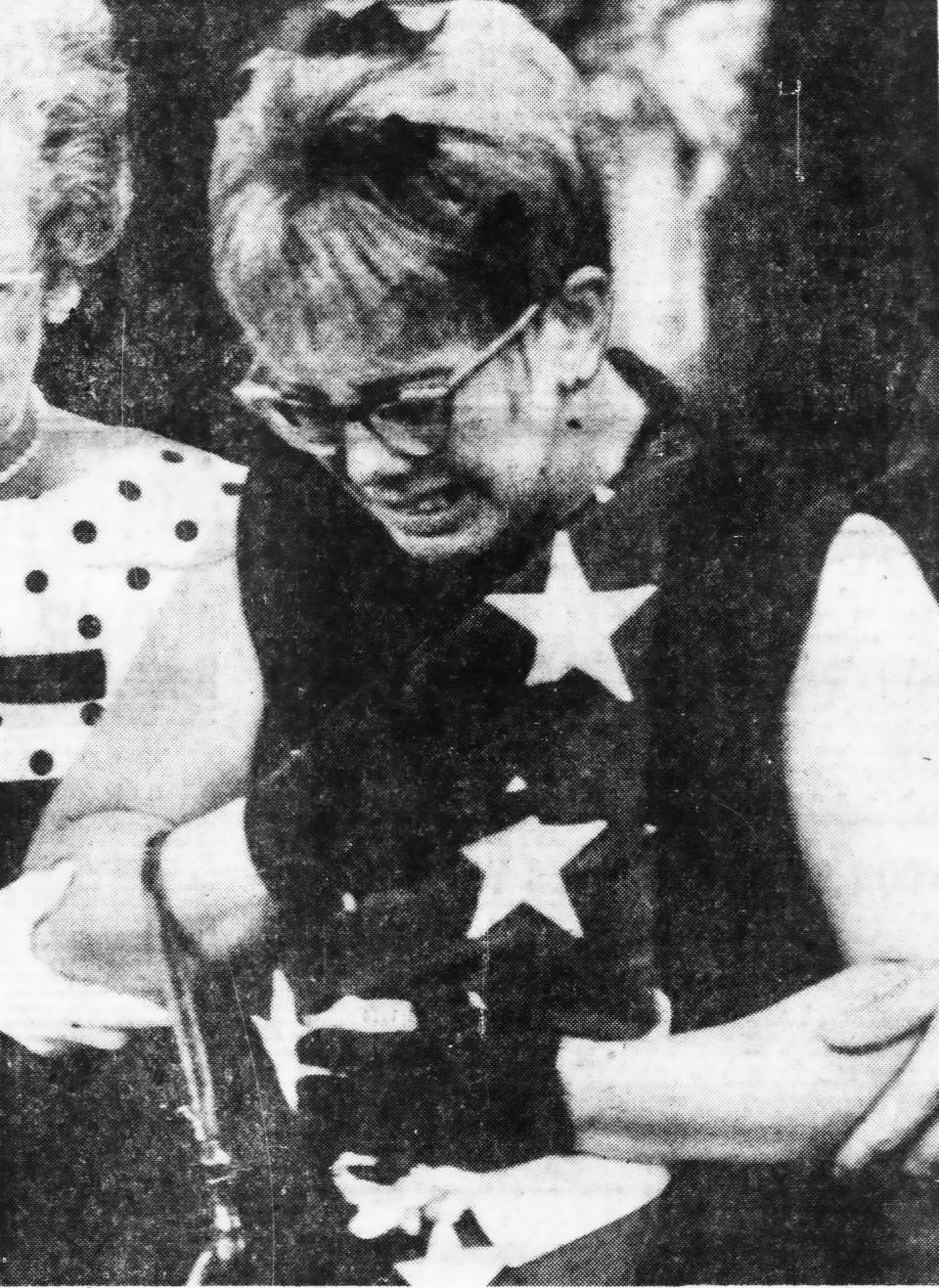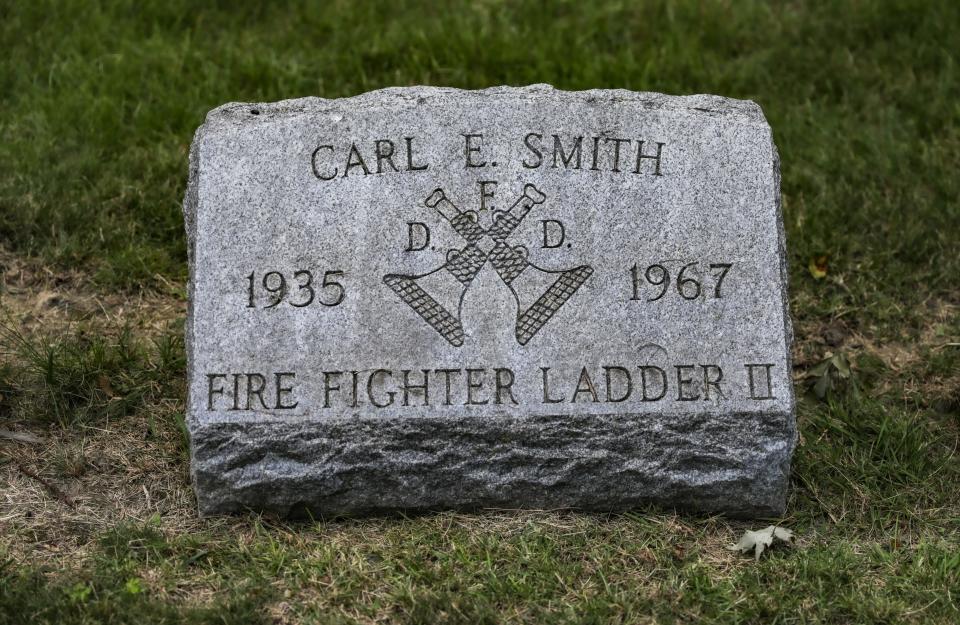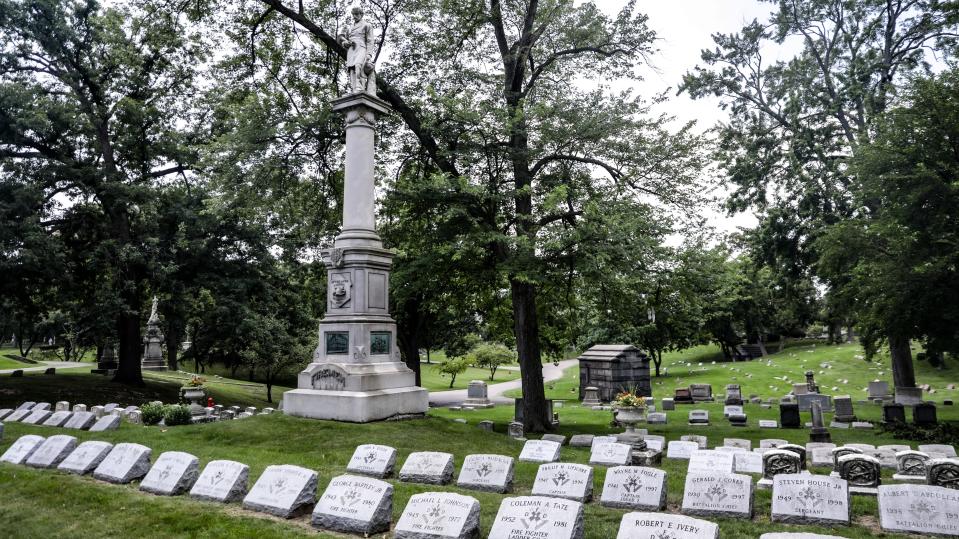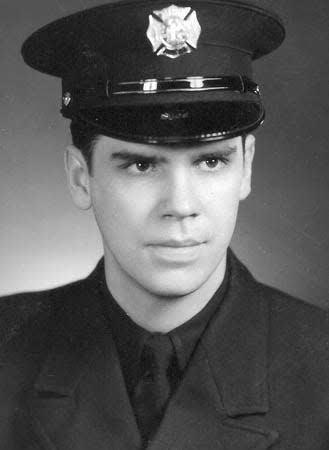Free Press Flashback: In 1967, Detroit firefighter might have been killed by friendly fire
Detroit firefighter Carl E. Smith died 56 years ago Monday, on the second night of the 1967 rebellion. This Flashback contains two stories. The first story describes his funeral. It ran on July 30, 1967. The second was part of an investigation by the Free Press into the deaths of 43 people killed in the unrest. It appeared Sept. 3, 1967, and was part of the Free Press coverage of the rebellion and its aftermath that won a Pulitzer Prize in 1968.
Carl E. Smith died doing his duty, a martyr to the forces of sanity in a city suddenly gone mad.
Saturday a grateful city with an aching heart paid its last respects to Carl Smith, 32, the avid, eager firefighter, the guy they called "commissioner" down at Ladder Company 11 because he was quick to give orders.
Smith, husband of slim, light-haired Patricia Ann and father of crew-cut, 4-year-old Dwayne, was killed by a bullet Monday as he darted across Mack, trying to get back to his rig on the corner of Mack and St. Jean. He had volunteered for duty.

Officially, he was on the sick list, recuperating from an emergency appendectomy. But he came, like hundreds of other firefighters, because he knew they needed him to fight the fires of Detroit's disastrous riot.
Saturday, Carl Smith was laid to rest in Elmwood Cemetery, in the plot dotted with headstones carved with two trumpets, the firefighter's symbol.

After services at Girrback Funeral Home in River Rouge, the funeral cortege moved downtown, past the black-draped rigs gleaming in the sun at Fire Department Headquarters, past the white gloved men, standing at attention. Smith's flag-draped coffin rested atop a new pumper.
‘Nearer my God to Thee’
Near the cemetery, an honor guard of nine red-suited firemen and six blue-uniformed American Legionnaires marched slowly, to the tap of muffled, black-draped drums.
More than 1,000 of Smith's comrades, a long blue line of firefighters, marched to the cemetery and stood at attention. Mostly, they came from Detroit. But there were men from Windsor, Southfield, Warren, Highland Park – some of the 40 or more communities that helped out in the emergency. They also came from as far away as Cleveland and New York.

Mayor Jerome Cavanagh, his face grim, his shoulders hunched, marched beside Fire Chief Charles J. Quinlan. There were common councilmen and other dignitaries.
The band played "Nearer My God to Thee" and they took Carl Smith's coffin down from the truck. The minister spoke the comforting words "The Lord is my shepherd. I shall not want.”
They took the flag from Carl Smith's coffin and folded it in a triangle. Quinlan handed it to Mrs. Smith.
Mayor Cavanagh shook her hand and said a few words. But for the pretty young woman in the black dress there could be no comfort, not now. And for a little boy, all dressed up in a suit and a white shirt, there could be no understanding.
As the echo of taps died away, she sobbed and caressed a white star on the flag; and cried, "Oh, Carl! Carl!" The little boy, only 4 and too young to understand, clutched at his mother's skirts.
He looked up at her tear-drenched face and said: "Mommy, don't cry, Mommy."
Did an errant shot from the National Guard kill Smith?
By Barbara Stanton, Gene Goltz and William Serrin, Special to the Free Press
In fishing, playing golf or softball, Carl Smith was always the sparkplug. Around the fire station he was the take-charge guy.

"You and you and you, come with me," he would say on a fire-drill exercise. "You," he would point at another fireman, "stay here."
He had all the qualities of a fire chief, the men used to say jokingly, except the rank. In his four years with the Detroit Fire Department, he was one of the hardest workers and was clearly devoted to the job.
His enthusiasm accounted in some part for his death. Smith, of 15322 Santa Rosa, was shot through the head and killed instantly at 11:30 p.m., July 24, when he and other firemen were pinned down by sniper fire at Mack and St, Jean.
It is possible Smith was killed by a sniper. It is equally possible he was killed by a National Guard bullet. After a thorough investigation, homicide detectives reconstructed Smith's death this way: He was assigned to Engine Company 13, which was assembled with other fire fighting units at Mack and St. Jean. This area was being used by the fire department as a mobilization point.
‘See the action’
Just before 11:30, the fire station at 3872 St. Jean (just north of Mack) was attacked by snipers. Several fire vehicles and the firemen in the street were pinned down by what was described as "heavy sniper fire." The massive counter attack by police and National Guard undoubtedly contributed to the heavy firing.
In fact, there was heavy and continuous shooting on all sides, witnesses said. The firemen were ordered to evacuate the area. Smith was isolated, for an unknown reason, on the southeast corner of Mack and St. Jean. His fire truck and his buddies were on the other side of St. Jean.
Fellow firemen speculated later that Smith may have wanted to "see the action," and that was why he was south of Mack. He ran north across the street toward his fire truck. As he reached the northeast intersection of Mack and St. Jean, he crouched behind a rubbish receptacle.
At this point, Police Sgt. Roy Snyder saw Smith clasp his hand to his head and pitch forward on the sidewalk. Because of the heavy firing, it was 40 minutes before an ambulance could remove Smith's body. An autopsy conducted by Dr. Joseph Juliar, assistant Wayne County medical examiner, determined that a high-powered rifle slug had passed through Smith's head on an even plane.
Detectives said police stated that sniper fire had originated from rooftops southeast of Smith, in the 11400 block of Mack. They also determined that the lethal bullet had been fired from street level from near the intersection of Mack and Gladwin. They recovered a copper jacket from a spent .30 caliber bullet which had struck a building on the northwest corner of Mack and St. Jean. The projectile was in the path of the trajectory apparently taken by the bullet that killed Smith.
The lead was not recovered, but the ballistics laboratory of the police department said the jacket was fired from a .30 caliber carbine. The National Guardsmen were equipped with both M-l caliber rifles and .30 caliber carbines.
Smith's position was in the middle of a hail of bullets between Guardsmen and police and the snipers on the rooftops. The detectives' report said that Smith was looking in the direction of the rooftop sniper fire and thus in the direction from which the fatal street-level bullet came. But they do not offer any evidence to support this.
The available evidence leaves two possible conclusions: Either Smith was killed by a sniper who was on the street at ground level at Mack and Gladwin, unknown to anyone present. Or he was killed accidentally by a National Guardsman's bullet.
This article originally appeared on Detroit Free Press: Flashback: In 1967, friendly fire might have killed Detroit firefighter

